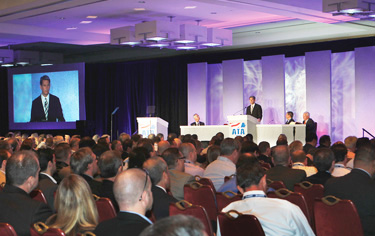Truckers Told Nat Gas Growth Depends on Related Changes

This story appears in the Dec. 3 print edition of Transport Topics.
ARLINGTON, Va. — The emergence of natural gas as a viable fuel for trucking is dependent on progress in overcoming infrastructure hurdles such as a dependable fuel supply network, a new generation of engines and driver acceptance, industry experts said last week.
“The big question is timing,” James Haslam II, chairman of Pilot Flying J, said when he addressed the American Trucking Associations’ Summit on Natural Gas in Trucking here on Nov. 29.
The summit, which continued on Nov. 30, after this edition was printed, attracted executives from fleets, tractor and engine manufacturers, and truck stop operators, suppliers and scientists. All were seeking to gauge the commercial promise of an alternative fuel to diesel, whose price stubbornly remains around $4 a gallon.
ATA President Bill Graves, who moderated a panel of truck stop executives, illustrated the broad interest in the subject by saying that “people always pose the question” about the future of natural gas as a truck fuel wherever he travels. The event drew an overflow crowd of more than 500 attendees.
“The energy boom is the single greatest thing the country has going for it,” Pilot’s Haslam said. “We have to take advantage of this. The best place to do it is with trucks. We believe we will have the infrastructure in place to take care of your needs.”
Pilot Flying J is backing up that stance by building a natural-gas fueling network in partnership with Clean Energy Fuels Corp. The plan is to have 70 locations equipped by the end of this year and 150 by the end of 2013.
Thomas O’Brien, the CEO of TravelCenters of America, agreed but said the investment is too great to take on alone.
“Natural gas is a very viable option over the long term,” he said. “The demand today from customers, frankly, is not sufficient to start this on my own.”
O’Brien’s chain is proceeding, though, because it has created a natural gas supply partnership with Shell Oil to develop 100 fueling stations at TA locations.
“We are in tests as an industry,” said Frank Love, president of Love’s Travel Stops. “A year from now, we will see the availability of those engines. They will have to be priced with a comparably equipped diesel engine. They are not there today, but they will be in the future.”
To further that goal, Freightliner Trucks announced last week it was introducing a Cascadia 113 model aimed at the regional and less-than-truckload markets that fleets could test.
Love said his company is entering the natural gas market with a focus on compressed natural gas for regional hauls.
He focused on the importance of creating an engine that is both heavy-duty and durable as a key factor to advancing natural gas fueling.
In addition, he said that fueling facilities will have to be equipped to fill tanks as quickly with compressed natural gas as they do with diesel to maintain driver productivity and satisfaction, CNG can take as much time as 45 minutes to fill a tank, compared with filling a tank with diesel as quickly as 10 minutes.
Love’s Travel Stops solved that problem by creating a fast-fill station in Oklahoma that delivers CNG at the same speed as diesel.
Making the natural gas fueling experience driver-friendly also is important, Haslam said, noting that drivers will need to wear protective gloves and goggles for liquefied natural gas.
O’Brien said that driver acceptance could be difficult, but the fleets will be making the investment and ultimately will require the drivers to adapt.
Love said the larger issue from the driver’s standpoint was the truck itself because of the general acceptance of the 11.9-liter engines, but smaller ones weren’t popular with drivers.
Asked about when natural gas fuel would gain commercial acceptance in trucking, O’Brien cited a consultant’s study that projected a 7% market share for those engines in five years.
Haslam didn’t give a timeframe but said the market would evolve, based on engine availability and the future price differential between natural gas and diesel fuel.
That difference now is about $1.50 between a gallon of diesel and the natural gas equivalent, said Andrew Littlefair, president of Clean Energy Fuels, who described trucking “as the last market [for natural gas] to crack.”
He said market acceptance for over-the-road trucking could be about five years away, based on the experience of the refuse removal industry. In that industry, he said, natural gas vehicles first came into general use in 2008 and now have taken more than half of the market for new trucks by this year. Similar inroads have been made for natural gas-powered transit buses, he said.
The important factor, he said, was a swift payback for the investment in natural gas equipment.
“That will have to happen for truckers, too,” Littlefair said. “These [trucking companies] are smart operators. They have to get payback.”
He cited the example of refuse company Waste Management Inc., which was able to recover its investment in natural gas trucks within a year because of lower fuel costs.
“Given the rapid technological advancements in natural gas extraction methods and vehicle technologies, coupled with exceedingly attractive pricing, we are truly on the cusp of a potentially revolutionary change in the trucking industry,” ATA Chairman and Combined Transport CEO Michael Card said.
The luncheon speaker at the Nov. 29 session, oil industry investor T. Boone Pickens, said it would be in the best interests of the trucking industry to embrace natural gas to reduce dependence on imported oil and to ensure future fuel supply. In addition, he noted that natural gas is 75% cheaper in the United States than in other countries around the world.
“We are going to be in business together,” Pickens said. “Let’s get on our own resources in this country and get off OPEC oil.”
Staff Reporter Seth Clevenger contributed to this report.




